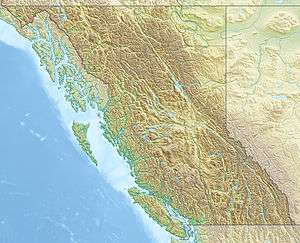Mount Lloyd George
Mount Lloyd George is a 2,938 metres (9,639 ft) peak in British Columbia, Canada, rising to a prominence of 1,208 metres (3,963 ft) above Lloyd George Pass. Its line parent is Mount Sylvia, 37 kilometres (23 mi) away. It is part of the Northern Rocky Mountains.[1]
| Mount Lloyd George | |
|---|---|
 Mount Lloyd George | |
| Highest point | |
| Elevation | 2,938 m (9,639 ft) [1] |
| Prominence | 1,208 m (3,963 ft) [1] |
| Parent peak | Mount Sylvia |
| Coordinates | 57°53′45″N 124°59′52″W [1] |
| Geography | |
| Parent range | Northern Rocky Mountains |
Geology
Lying in the Muskwa Ranges, Mount Lloyd George is a castellated limestone and quartzite peak.[2] The diamictite sedimentary deposits of the mountain, several kilometers thick, date to the late Precambrian and probably have a glacial-marine origin.[3] The age of the diamictite is not certain. It may be associated with either the Toby or the Vreeland formations of the North American Cordillera.[4]
Ice field
The Lloyd George Icefield in 1998 covered over 70 square kilometres (27 sq mi).[5] There is a major concentration of glaciers around the mountain. The icefield is about 19 kilometres (12 mi) from north to south and 13 kilometres (8.1 mi) from east to west, bounded by the Warneford River and the Tuchodi River. The small Llanberis Glacier flows west from the icefield to Hawarth Lake. The larger Kwadacha and Lloyd George glaciers drain the icefield to the east.[6]
Name
The mountain was named by Paul Leland Haworth after David Lloyd George, the British Prime Minister towards the end of World War I. In the words of Raymond M. Patterson,
It has been said, and with some truth, that the Rockies are the worst named mountain system in the world... Haworth, in a fit of wartime enthusiasm, decided to suggest that one further alien name be added to the ill-assorted register: as soon as he got out he would propose to Ottawa that the high mountain he had seen that day, holding the Great Glacier in its lap, should be called Mount Lloyd George. With regrettable haste his suggestion was adopted. Time and the verdict of history have not added to the stature of the little Welsh politician.[7]
References
Citations
- Mount Lloyd George - Bivouac.com.
- US Geological Survey 1998, p. 1200.
- Anderson & Molnia 1989, p. 6.
- Arnaud, Halverson & Shields-Zhou 2012, p. 421.
- US Geological Survey 1998, p. 1275.
- US Geological Survey 1998, p. 1277.
- Akrigg & Akrigg 1997, p. 155.
Sources
- Akrigg, G. P. V.; Akrigg, Helen B. (1997). British Columbia Place Names. UBC Press. p. 155. ISBN 978-0-7748-0637-4. Retrieved 2012-10-21.CS1 maint: ref=harv (link)
- Anderson, John B.; Molnia, Bruce (1989). Glacial-Marine Sedimentation. American Geophysical Union. ISBN 978-0-87590-706-2. Retrieved 21 October 2012.CS1 maint: ref=harv (link)
- Arnaud, E.; Halverson, G. P.; Shields-Zhou, G. (2012-06-30). The Geological Record of Neoproterozoic Glaciations. Geological Society. ISBN 978-1-86239-334-9. Retrieved 2012-10-21.CS1 maint: ref=harv (link)
- "Mount Lloyd George British Columbia". Bivouac.com. Retrieved 2012-10-20.
- US Geological Survey (1998). Geological Survey Professional Paper. U.S. Government Printing Office. Retrieved 21 October 2012.CS1 maint: ref=harv (link)